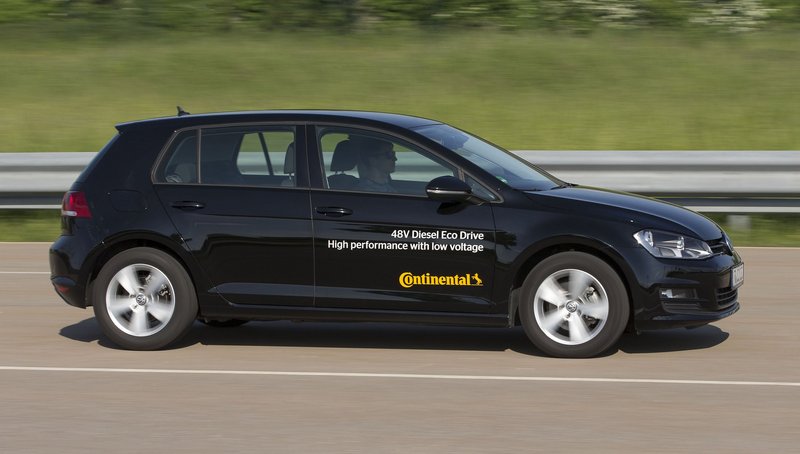48 V Eco Drive from Continental Makes Diesel Vehicles Cleaner and More Economical
- Low-voltage electrification reduces the consumption of the already economical diesel even further and enables additional benefits in terms of emissions
- Start of series production at Continental for a 48 V Eco Drive diesel application will follow in 2016
Frankfurt, Regensburg, August 11, 2015. At the IAA 2015, the international automotive supplier Continental will be showing that the benefits of low-voltage hybridization, already demonstrated to impressive effect in vehicles with gasoline engines, can achieve considerable savings in fuel consumption in combination with a diesel engine as well. For this purpose, Continental has integrated its innovative 48 V Eco Drive technology in a mid-size class model with a 1.6 l TDI drive. "With the hybrid driving strategies that are enabled by our 48 V Eco Drive concept, the consumption of the economical compression-ignition engine can be reduced again. In addition, the support from the electric motor can be used to reduce the emissions of the diesel engine even further," said Dr. Oliver Maiwald, Head of Technology & Innovations at Continental, Powertrain Division.
The 48 V Eco Drive system was also retrofitted to the Diesel Eco Drive demo vehicle without any significant interference in the existing vehicle architecture. Continental deliberately chose this approach for the development of the 48 V Eco Drive system to make it suitable for the mass market from a cost perspective. The Continental SOPs of two series-production applications for 48 V Eco Drive hybridization are already scheduled for 2016, including one in combination with a gasoline engine and the second in combination with a diesel engine. "What we will be showing at this year's IAA Cars in Frankfurt are not concepts but the results of close collaboration with customers," continues Maiwald. "We believe that one of our duties as a leading technology company is to help efficiency technologies to break through by means of suitable development approaches."
Benefits in gasoline engine confirmed in diesel drive as well
The way in which the 48 V Eco Drive works in diesel engines is fundamentally no different from the benefits already demonstrated in gasoline engines. Electrification enables efficient hybrid driving strategies, such as recuperation and coasting (driving with the combustion engine switched off), to be used in order to reduce fuel consumption. As often as the driving situation enables, the combustion engine is switched off and a sophisticated electronic control unit decides on the best way of using recuperation and coasting in order to optimize battery charge and vehicle efficiency. Calculations with the Diesel Eco Drive vehicle promise additional consumption savings of 7–9 percent.
To ensure high acceptance of the engine deactivation function, it is important to initiate the restart of the combustion engine at the end of a switched-off phase as quickly and quietly as possible. This is one of the strengths of the 48 V technology, which takes the engine to approximately 700 revolutions in less than 200 ms in the Continental Eco Drive using the Premium Start function. In comparison with 12 V systems, this yields a distinct acoustic advantage and makes restarting the diesel engine so quiet as to be barely noticeable.
The 48 V system in the Diesel Eco Drive is also used to prevent the combustion engine from operating in unfavorable states. This is particularly the case during acceleration. Here, the torque request sent to the combustion engine can be reduced and the missing torque provided by the electric motor. "In this way, the diesel engine can be operated more consistently and under the most favorable conditions," explains Maiwald. "With this option, engine developers can mitigate the buildup of nitrogen oxide and soot in certain load ranges." Depending on the engine development objective of the vehicle manufacturer and the exhaust aftertreatment technology in place, such as SCR (selective catalytic reduction), there is thus greater freedom to optimize the efficiency of the engine and vehicle emissions in equal measure. Measurements (in accordance with NEDC – New European Driving Cycle) have shown that this measure reduces nitrogen oxide emissions from the Diesel Eco Drive vehicle by up to 10 percent and by up to 20 percent in the new WLTC (Worldwide Harmonized Light Vehicle Test Cycle).

Simone Geldhäuser
Head of Media Relations, Spokesperson Finance, Business and Technology
Vitesco Technologies
